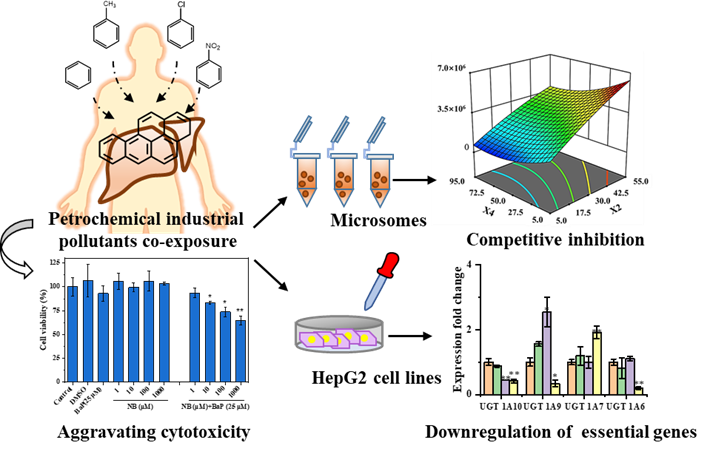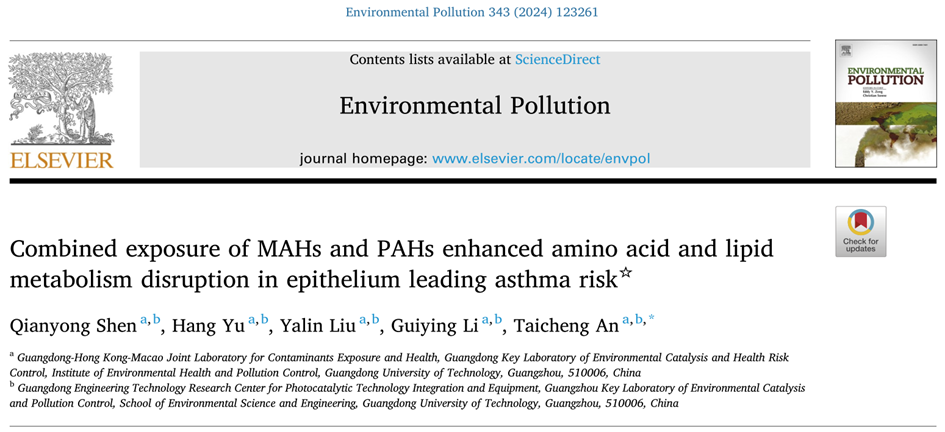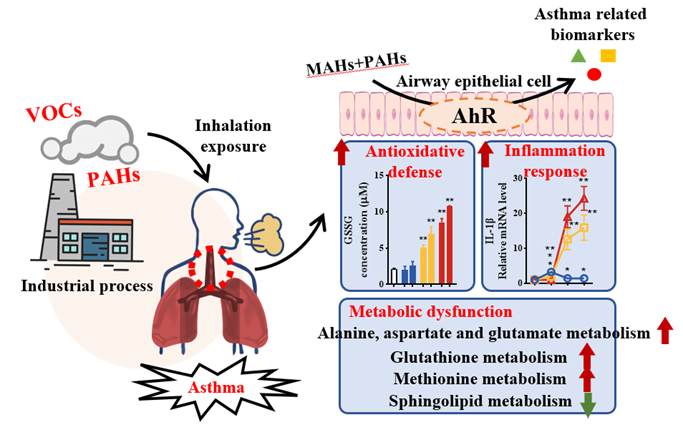近日,广东工业大学环境健康与污染控制研究院、环境科学与工程学院安太成教授团队在石化场地典型污染物复合暴露毒性效应与潜在健康风险研究方面取得最新研究进展,其中2篇研究成果分别以《Co-exposure health risk of benzo[a]pyrene with aromatic VOCs: Monoaromatic hydrocarbons inhibit the glucuronidation of benzo[a]pyrene, Environmental Research,2023,219,115158》和《Combined exposure of MAHs and PAHs enhanced amino acid and lipid metabolism disruption in epithelium leading asthma risk, Environmental Pollution,2024,343,123261》为题分别发表在Environmental Research 与Environmental Pollution期刊上。论文的第一作者为博士生沈钱勇,通讯作者为安太成教授。在这项系列研究中,团队人员采用微粒体与细胞模型,并结合非靶向代谢组学技术,分别从污染物复合暴露阻碍自身生物转化(尤其是Ⅱ相代谢过程)与干扰内源分子标志物两个方面,研究了苯系物与多环芳烃类化合物复合暴露对人体增加的毒性效应,分子机制与潜在疾病风险。这方面的系列研究为准确评估石化场地多种污染物复合暴露的毒性效应与人群健康风险提供重要参考。

论文1的网址: https://doi.org/10.1016/j.envres.2022.115158
石化场地职业暴露工人及周边居民在日常工作生活中不可避免地暴露于多种环境污染物。从生物代谢转化的角度,这些化合物相互作用影响细胞毒性与造成不准确的健康风险评估需做更深入的研究工作。本研究选择石化场地典型多环芳烃苯并芘(B(a)P)作为目标污染物,探究4种苯系物(苯,甲苯,氯苯与硝基苯)与其复合暴露对肝细胞生物毒性的影响与潜在生物机制。并通过中心响应面方法设计实验并优化微粒体暴露参数与不同参数之间相互作用对BaP代谢的影响。响应面结果表明:BaP的代谢受苯系物复合暴露浓度影响,同时发现苯系物浓度与微粒体浓度/孵育时间相互作用也会共同影响其生物代谢转化。特别地,通过不同的微粒体孵育体系发现苯系物共暴露能够通过竞争与时间依赖的方式抑制BaP重要的Ⅱ相解毒过程,葡萄糖醛酸化。与4种苯系物共暴露时,发现BaP 2种葡萄糖醛酸化代谢产物OH–BaP-G与diOH-BaP-G的含量分别下降至BaP单一暴露的43%~80%与32%~71%。此外,还发现在HepG2细胞中,苯系物与BaP共暴露显著降低UGT 1A10与BCRP/ABCG2的基因表达,这可能会通过抑制BaP的葡萄糖醛酸化过程与代谢产物跨膜运输,从而阻碍BaP在生物体内的解毒。因此,复杂环境污染物复合暴露会通过干扰各自代谢通路阻碍解毒过程,使其毒性中间体在细胞中累积,从而可能造成更高的毒性效应。本研究为准确评估有机污染物的复合暴露的毒性效应与健康风险提供参考。

Occupational workers and residents near petrochemical industry facilities are exposed to multiple contaminants on a daily basis. However, little is known about the co-exposure effects of different pollutants based on biotransformation. The study examined benzo[a]pyrene (BaP), a representative polycyclic aromatic hydrocarbon related to the petrochemical industry, to investigate changes in toxicity and co-exposure mechanism associated with different monoaromatic hydrocarbons (MAHs). A central composite design method was used to simulate site co-exposure scenarios to reveal biotransformation of BaP when co-exposed with benzene, toluene, chlorobenzene, or nitrobenzene in microsome systems. BaP metabolism depended on MAH concentration, and association of MAH with microsome concentration/incubation time. Particularly, MAH co-exposure negatively affected BaP glucuronidation, an important phase Ⅱ detoxification process. BaP metabolite intensities decreased to 43%–80% for OH–BaP-G, and 32%–71% for diOH-BaP-G in co-exposure system with MAHs, compared with control group. Furthermore, glucuronidation was affected by competitive and time-dependent inhibition. Co-exposure significantly decreased gene expression of UGT 1A10 and BCRP/ABCG2 in HepG2 cells, which are involved in BaP detoxification through metabolism and transmembrane transportation. Therefore, human co-exposure to multiple contaminants may deteriorate toxic effects of these chemicals by disturbing metabolic pathways. This study provides a reference for assessing toxic effects and co-exposure risks of pollutants.
项目资助:
本研究得到国家重点研发重点专项项目(2019YFC1804503与2019YFC1804502)、国家自然科学基金(41731279, 41991311与41907363)、广东省本土创新科研团队(2017BT01Z032)的大力支持。
系列研究成果2:

论文2的网址:https://doi.org/10.1016/j.envpol.2023.123261
苯系物(Monoaromatic hydrocarbons,MAHs)与多环芳烃(polycyclic aromatic hydrocarbons,PAHs)是化工场地典型的空气污染物,能够引起多种呼吸道疾病,如哮喘,慢性非阻塞,肺癌等。而复杂环境污染物,如MAHs与PAHs诱导哮喘发生的潜在生物机制仍不明确。本研究中,我们系统探讨了8种MAHs的混合物,16种 PAHs的混合物以及全部24种化合物的混合物(MIX)对人呼吸道上皮细胞(Human bronchial epithelial,16-HBE)的毒性效应。48 h MIX暴露后,3种哮喘警示因子(TSLP,IL-25与IL-33)的基因表达显著上调,表明MIX暴露增加了哮喘发生的潜在风险。MIX暴露能够通过激活芳香烃受体诱导氧化应激与炎症反应标志物转录水平的上调,主要包括SOD-2,NQO-1,IL-1β,IL-6与IL-8,分别上调至对照组的3.1,19.9,23.4, 18.7与28.1倍,表明MIX暴露加剧了哮喘相关的不良生物反应。通过非靶标代谢组学研究,在MAHs,PAHs与MIX暴露组分别筛选识别出了25,49与59种差异代谢物。富集分析表明MIX暴露主要干扰了16-HBE细胞中氨基酸与脂质代谢通路,包括丙氨酸,天冬氨酸和谷氨酸代谢;谷胱甘肽代谢;蛋氨酸代谢和鞘脂代谢,这些代谢通路参与细胞中抗氧化防御与炎症反应。总之,MAHs与PAHs复合暴露增加了它们的毒性风险,为哮喘发生与恶化的生物机制研究提供了一定的理论参考。
图文摘要:

英文摘要
Monoaromatic hydrocarbons (MAHs) and polycyclic aromatic hydrocarbons (PAHs) are ubiquitous air pollutants from industry, with multiple adverse effects on respiratory system. However, the underlying mechanisms of their mixture to induce asthma is still unclear. Here, we examined mixture of 8 MAHs, mixture of 16 PAHs and a total mixture (MIX) on human bronchial epithelial (16-HBE) cells. Exposure to MIX resulted in increased expressions of asthma alarm cytokines (TSLP, IL-25 and IL-33), indicating potential asthma risk. Exposure to MIX led to significant upregulation of transcriptional level of oxidative stress and inflammation biomarkers through aryl hydrocarbon receptor activation, including SOD-2, NQO-1, IL-1β, IL-6 and IL-8 with 3.1, 19.9, 3.5, 23.4, 18.7, 28.1-fold change, indicated asthma related epithelial cell lesions. A total of 25, 49 and 59 differential metabolites were identified in cells response to MAH, PAH and MIX exposure, respectively, and enrichment analysis demonstrated MIX exposure disturbing alanine, aspartate and glutamate metabolism, glutathione metabolism, methionine metabolism and sphingolipid metabolism, involved in antioxidative defense and inflammation response. Combined exposure of MAHs and PAHs may result in increased toxic risks, and provide evidence to asthma onset and deterioration.
项目资助:本研究得到国家重点研发重点专项项目(2019YFC1804503与2019YFC1804502)、国家自然科学基金(41731279)、广东省科学技术项目(2022-GDUT-A0007)的大力支持。
|